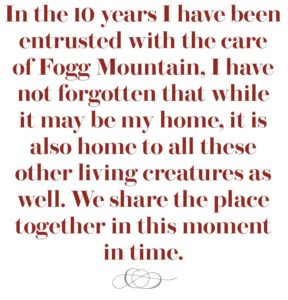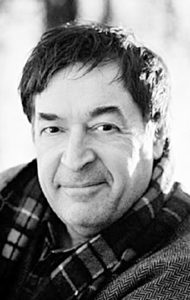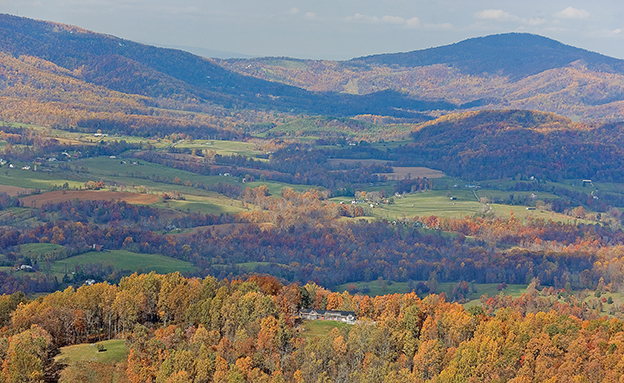“Walking through my forest is akin to being inside a Gothic cathedral,” says the author.
By Ron Maxwell
I live in a tenement. I have chosen to live there, cheek by jowl with many neighbors. I see their comings and goings, hear their chatter. Some go about their business during the daylight hours. Some only stir at night. I haven’t met each and every one of my neighbors. Some are more neighborly than others. Some are curious about me. Others downright reclusive.
The walls of my tenement are alive. I don’t mean that in a figurative sense. They are literally living things, with births, with spans of life, with deaths. Most will outlive me. For you see, this tenement teeming with life, the place that I call home, is a forest.
Of the 75 acres on the summit of Fogg Mountain under my current custodianship, about 60 are in forest. The other 15 or so acres were cleared in 1993 by the previous owner, who built the house. In the 10 years I’ve lived here, I’ve discovered ancient stone walls and the stone foundations of a small dwelling. These were found in the protection of a valley within the property.
Prior to the second half of the 20th century, no one in their right minds would construct a dwelling on the very summit of a mountain. Fogg Mountain is U-shaped Shangrila hidden within its folds. It was there, in this defile, shielded from winter blizzards and summer squalls, that the 18th-century pioneers made their home.
I’ve often wondered who those people were, what they did there, why they built those walls and how their daily lives were lived. Locals say the walls were there as enclosures for livestock. Most of the trees at that earlier epoch would have been cleared to make room for pasture and crops. And for fuel. 17th- and 18th-century colonists consumed entire forests for fuel to provide the warmth needed to survive the desperately cold winters. Today, a second-growth forest inhabits the premises. It took me many hours with a machete to hack through the dense underbrush, the tenacious thorn armored vines to uncover the remains of the former human habitation.
Fogg Mountain is an elaborate, inter-connected and interwoven ecosystem dominated and defined by the towering second-growth trees which comprise the foundations of the wildlife habitat. Two homo sapiens, my wife and myself, as well as our five dogs, are its most recent visitors. Recognizing the fecundity of the natural world of which we are only a part, we treat our habitat with understanding, respect and affection. As soon as it clicks into focus — as soon as the emotional connection is made — behavior, attitudes, decisions and actions align.
For us, who temporarily, in our brief tenure as property owners, hold all the power — the power of life and death over all other living things on the mountain — personal restraint and soulful modesty emerge as vitally important ways of living.
How is this forest connected to us?
The trees are the roof, the canopy, the dwelling place, the roots, the branches, the bark, the seeds, the blossoms and the leaves of life. The trees are the home of home, such as the first tree, the tree of life. Every time we are under a tree, held within its embrace, resting in its shade, we are once again Adam, once again Eve.
My daily routine is to walk with my dogs into the forest. At intervals I have placed hammocks or benches, where I can lie down, slow down, and except for my breathing, become perfectly still. The dogs too, after an initial time of curious sniffing about the ground, also settle down. In this stillness, the facade of emptiness gradually dissolves to reveal the extraordinary complexity of forest life: insects on the forest floor, turtles lumbering through the old carpet of leaves, chipmunks darting through the grass, squirrels scurrying from branch to branch, and way up in the highest reaches of the canopy, birds and more birds. They are silent at first, but once the dogs and I have settled down, their singing starts, grows in intensity and before long we are experiencing an auditory sensation exceeding the finest surround systems of any state of the art multiplex theater.
After the setting of the sun, the night belongs to the mammals: deer, raccoon, groundhog, bobcat, rabbit, possum, porcupine, foxes, wild turkeys and bears. In the summer months, first the crickets, then the tree frogs, tune their instruments for their nightly cacophony.
There is life, of course, in other habitats, in open fields, in estuaries, in rocky outcroppings. But there’s something about a forest, a quality of existence belonging to and imparting from trees which creates a many-storied, multi-dimensional, quadraphonic life experience.
Walking through my forest is akin to being inside a Gothic cathedral, the shafts of light filtered, refracted and diffused by layers of branches and leaves, not unlike the effect of the light passing through stained glass, illuminating a sacristy or choir.
Not only home to many other species, including we humans, trees are a universe unto themselves. We are reminded that we can know the age of trees by counting their rings. In 1964 a bristlecone pine in Nevada was discovered to contain 4,676 rings. It was appropriately named Methuselah.
 To put this into human perspective, it was already more than 2,000 years old at the time of the Christ and alive before Moses received the Ten Commandments on Mount Sinai. That tree is a reminder of our own mortality, of our own fragility. Our own life spans, measured against a tree’s, are as flighty and ephemeral as a bumble bees. In our sometimes species’ centric myopia, it is easy to think that we are the masters of the universe and the determiner of all things and the ones who hold the hour glass of time within our own frail human hands.
To put this into human perspective, it was already more than 2,000 years old at the time of the Christ and alive before Moses received the Ten Commandments on Mount Sinai. That tree is a reminder of our own mortality, of our own fragility. Our own life spans, measured against a tree’s, are as flighty and ephemeral as a bumble bees. In our sometimes species’ centric myopia, it is easy to think that we are the masters of the universe and the determiner of all things and the ones who hold the hour glass of time within our own frail human hands.
In the 10 years I have been entrusted with the care of Fogg Mountain, I have not forgotten that while it may be my home, it is also home to all these other living creatures as well. We share the place together in this moment in time. These wild animals, no less than my domesticated canine companions, are my family.
This is no marijuana-induced, Age of Aquarius delusion; this is only a sober acknowledgement of what really is there, right before our eyes. Once this reality is accepted, indeed embraced, it is liberating to the human soul. Suddenly, things once perceived as in the way, or as nuisances, or simply as exploitable commodities — are transformed. Of course, the trees and the creatures that inhabit the forest have not changed. We have changed. The scales have fallen from our eyes and we see, as if for the first time, what is really there, as well as the true value of things — a value that cannot be reduced only to entries on the ledger of a profit and loss statement.
I understand that we humans have always exploited the natural resources available to us. This also is a fact of life. We need to harvest trees, we need to mine minerals, we need to extract fossil fuels, we need to consume animal protein. We need, put simply and crudely, to temporarily destroy habitat and yes, to take life. This is the harsh reality.
Let us at the very least understand what we are doing. We must humanely manage renewable resources. We must never lose sight that all living things, including the longest and largest of all living things — trees — are worthy of our respect, that we humans are only one part of a greater fabric of life on earth. That we are interconnected and interdependent with all other life on earth — even in far-away continents and far-away oceans.
For us here in Virginia, it begins and ends with trees. St. Francis of Assisi spoke of Brother Sun and Sister Moon. Unlike our now treasured Native American forbears, I am not an animist. But one doesn’t have to worship trees to appreciate them, to protect them, to cherish them for future generations of wildlife and yes, of humans too.
St. Francis, speaking to us from the Renaissance, at a moment in time when Methuseleh, that bristle cone pine was already thousands of years old, shows us the way. We are indeed related to our trees, to our forests — and they are related to us. The advances of scientific research into our shared DNA have only confirmed what we instinctively already knew. It is in truth, Brother Elm and Sister Spruce.
About the Author:
 Ron Maxwell, who lives in Rappahannock County, is a film director, perhaps best known for “Gettysburg” and his latest production “Copperhead.”
Ron Maxwell, who lives in Rappahannock County, is a film director, perhaps best known for “Gettysburg” and his latest production “Copperhead.”

Leave a Reply